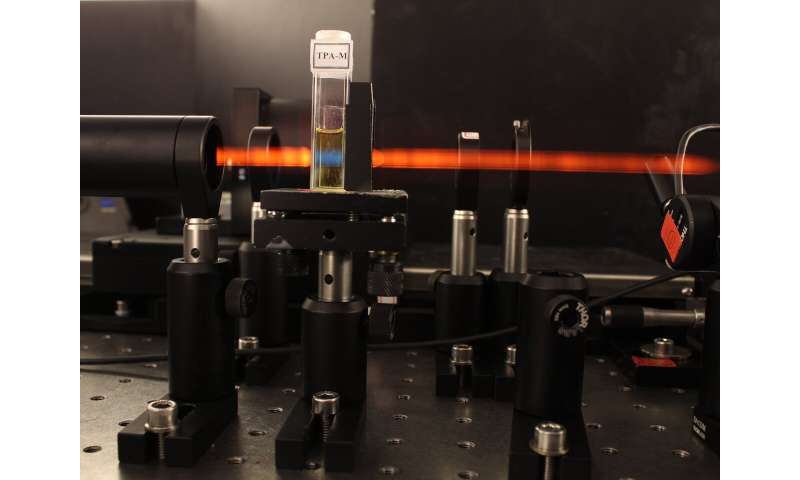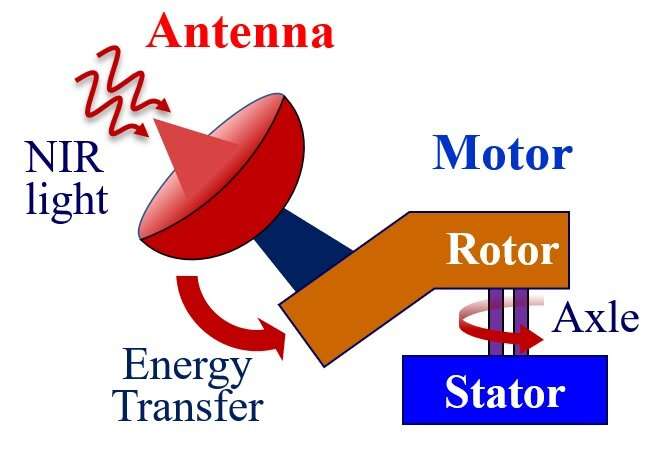
Light-controlled molecular motors can be used to create functional materials to provide autonomous motion, or in systems that can respond on command. For biological applications, this requires the motors to be driven by low-energy, low-intensity light that penetrates tissue. Chemists at the University of Groningen designed a rotary motor that is efficiently powered by near-infrared light, through adding an antenna to the motor molecule. The design and functionality were presented in the journal Science Advances on 28 October.
Ben Feringa, Professor of Organic Chemistry at the University of Groningen, presented the design and construction of the first light-driven unidirectional rotary molecular motor in 1999. In 2016, he was one of three winners of the Nobel Prize in Chemistry, for the design and production of molecular machines. His molecular motors have evolved since, but a major limitation for applications has been that they are powered by ultraviolet light. In many applications, UV light can be harmful to surrounding materials. Attempts to use less energetic near-infrared photons to power these motors have so far been unsuccessful.
Energy
Adaptation of the motor molecule to directly accept two low-energy photons instead of a high-energy one has not been successful. That is why scientists in the Feringa laboratory now tried a different approach. Through a covalent bond, the motor molecule was linked to an antenna that can absorb two near-infrared photons. The resulting excitation of the antenna is then passed on to the motor part of the molecule.
Much of this work was carried out by Lukas Pfeifer, a postdoctoral researcher in the Feringa laboratory, who now works at the Swiss École Polytechnique Fédérale in Lausanne. "For the system to work, the energy levels of the antenna and the motor had to be closely tuned," he explains. This meant designing a version of the molecular motor that requires the exact amount of energy that the antenna provides for movement. "And it also needed a linker that allows the antenna to be attached without interfering in the motor's rotation."

Simple
"This is a direct transfer of the excited state, very similar to the way in which two strings on a guitar will resonate when one of them is struck," explains Maxim Pshenichnikov, Professor of Ultrafast Spectroscopy at the University of Groningen and one of the authors of the Science Advances paper. The idea seems simple enough. "If you know how it works, it becomes really simple," says Pshenichnikov. "But the chemical design was certainly not trivial."
A complex sequence of events that sets the motor in motion takes place over a very wide range of times, from picoseconds (10-12 s) to minutes. The different time regimes were studied by Pfeifer using NMR and by Nong Hoang, a Ph.D. student in Pshenichnikov's research group, using ultrafast spectroscopy. First, the antenna captures two near-infrared photons. This is followed by the energy transfer that initiates motor motion. Fortunately, the design worked very efficiently.
Dream
"After many years of designing molecular motors, being able to overcome the need for high-energy UV light to power these molecular rotary motors is like a dream come true," says Ben Feringa. "I feel that our results represent an important milestone in the design of artificial molecular motors and offer many prospects for future applications, ranging from responsive materials to biomolecular systems."
The next step is to simplify the structure of the motor-antenna complex. That would allow the introduction of additional functionalities. A possible application of the new motor molecule is to function as a trigger to release the contents of a vesicle in a biological system. Pshenichnikov: "I am really curious to see how the next generation of this system will develop."
Simple Science Summary
In 1999, Ben Feringa, professor of organic chemistry at the University of Groningen, created the first light-driven molecular motor. These tiny motors could be used in all kinds of nanotechnology applications, for example in the delivery of drugs. However, they are powered by ultraviolet light, which can be harmful. Scientists have been looking for ways to use near-infrared light instead, but all attempts so far have been unsuccessful. Researchers from the University of Groningen now designed an antenna that absorbs energy from near-infrared light. This antenna was attached to the motor molecule, where it transmits the energy directly to the axle that drives motor movement. The result is a motor molecule that is powered by near-infrared light, which brings medical applications one step closer.
Explore further
Citation: Infrared light antenna powers molecular motor (2020, October 28) retrieved 28 October 2020 from https://ift.tt/3kG54rt
This document is subject to copyright. Apart from any fair dealing for the purpose of private study or research, no part may be reproduced without the written permission. The content is provided for information purposes only.
"light" - Google News
October 29, 2020 at 01:00AM
https://ift.tt/3kG54rt
Infrared light antenna powers molecular motor - Phys.org
"light" - Google News
https://ift.tt/2Wm8QLw
https://ift.tt/2Stbv5k
Bagikan Berita Ini














0 Response to "Infrared light antenna powers molecular motor - Phys.org"
Post a Comment